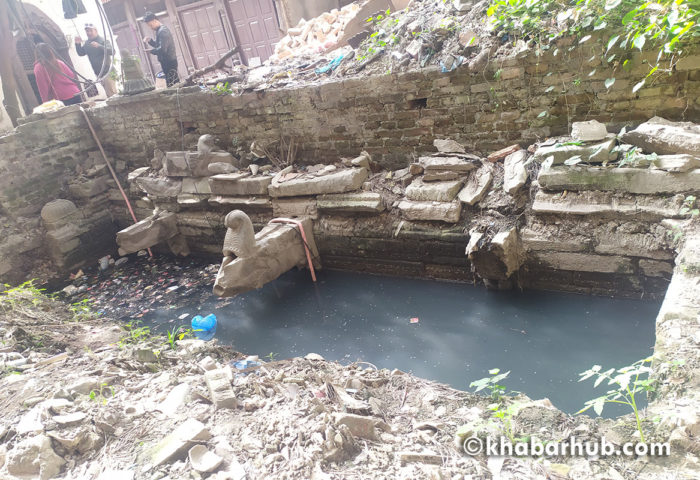0%

KATHMANDU: Dhunge dharas and hitis (stone spouts), the only and reliable source of water supply for the Kathmanduites in the past, have turned into dumping sites due to government negligence of late.
Phal Prasad Timalsina, hailing from Dhading, a priest at Baneshwor Temple, Durbar Marg, becomes nostalgic recalling the days when he could go to the stone spouts and bathe in the open enjoying the freshness of water and nature around without bothering about the water shortage. To him, it is only a memory now.
Near King Mahendra’s statue at Durbar Marg there are two temples: Baneshwor and Ram Temple. On the temple premises, there are three stone spouts which were formerly known as Sohra Hiti or ‘Teendhara’. A school was established after these spouts, later popularly known as Teendhara Pathshala. These spouts were the source of drinking water for locals and passersby for quite long. They used to enjoy the water until 2003.
“The spring water is so different”, said Timalsina adding, “Whenever we felt thirsty, we used to enjoy the freshwater of the stone spouts.”
Timalsina, cherishing the memories of past Teendhara, fetches water from the neighborhood and takes bath once a week now.

According to the record at the Department of Archaeology, Teendhara, which is in debris now, was built in the 14th century. Teendhara is also known as Sohra Hiti, which means ‘three spouts’ in Newari. Lately, the heritage campaigners are striving to preserve such spouts which, they think, reflect the ancient culture and civilization.
The spouts date back to 14th century
The stone spouts have been constructed each on four corners of Ranipokhari. Kathmandu City’s inventory of 2039 BS now in the department of Archaeology mentions that they were built by a person called Laxmi Narayan in the fourteenth century, nearly 700 years before.
Sadly, Teendhara premise is now wearing a deserted look. The area is now encircled by buildings resembling a dumping site owing to the dust and garbage discarded by the people living nearby. With the rise in consciousness about such heritage sites, protests are emerging. Recently, the huts and structures constructed invading the premises have been demolished in participation with the locals and conservationists. The renovation work is going on under the leadership of heritage campaigner Yadav Lal Kayastha.
“The garbage discarded at the site had covered Teendhara,” said Kayastha, “When we knew there was a spout, we intensified the search and found it hidden underground.” Now there is a small pool. Though the historical spouts are gone for good, Kayastha is relieved to see the source still oozing.
Kayastha, along with other cultural campaigners has filed a plea at the Department of Archaeology demanding the proper care and conservation of such heritage.
“The Department has sent a letter to the Ward Office,” says Kayastha, “and provided the ward office takes initiations and acts accordingly, there is the chance of giving life to these water spouts”.
Hitis on the brink of extinction
According to the record maintained by the Department of Archaeology, there are nearly 200 stone spouts in the valley now. Nearly half of the spouts have disappeared whereas those existing ones are lifeless, as no water comes through them.
When such historical and cultural icons are at stake, the concerned authority is expected to take the prompt lead. The negligence on their part denotes the cultural derailment.
The experts regard the unplanned urbanization, encroachment of the open space and the shifting human concern responsible for the deteriorating conditions of such sites.

Due to urbanization, infringement of the open space and concretization, the existence of the stone spouts is on the brink of extinction.
History of stone spouts in the valley
History witnesses the stone spout in Hadigaun built around 550 as the oldest stone spout of Kathmandu; another spurt at Gangahiti, Patan built around 570 is regarded as another ancient stone spout of the valley.
Likewise, Sundhara, the golden spout built in 1,828 near Dharahara, is regarded as one of the artistic spouts in the valley. The spout had been built by Bhimsen Thapa.
Although the construction of stone spurts dates back to an ancient age, such spouts got artistic touch since the Lichhavi era.
In the valley, the stone spouts have special religious importance. Twenty-two spouts of Balaju also known as Baisdhara of Balaju are the sites for holy bathing on Chaitra 15 (March 28) and Matatirtha (Mother’s Day). Similarly, nine spouts of Godawari, are famous centers for bathing at the Bahra Barshe Mela, a fair organized every 12 years.
Among the 573 spouts included in the research, 479 spouts were found to be the stone spouts. Fifty-two stone spouts were found invaded and destroyed whereas the whereabouts of 42 remained unknown. The research showed that out of 479 waterspouts in 10 municipalities, only 171 water spouts are still in existence.